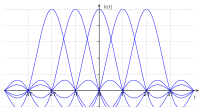
Photo from wikipedia
For synthetic aperture radars (SARs), an alternate transmitting mode based on waveform diversity is widely discussed for suppressing range-ambiguity in many letters, because it is easy to implement and there… Click to show full abstract
For synthetic aperture radars (SARs), an alternate transmitting mode based on waveform diversity is widely discussed for suppressing range-ambiguity in many letters, because it is easy to implement and there is no need to improve the pulse repetition frequency (PRF). These studies mainly focus on the discussion of pseudo-orthogonal waveform design, such as up–down chirp waveforms and orthogonal-frequency-division-multiplexing (OFDM) waveforms; however, the effect on imaging caused by waveform diversity is ignored. This letter, for the first time, provides a demonstrative derivation of imaging for the alternate transmitting mode, which will deepen the understanding of this mode and be helpful for the future research. In this letter, we point out that transmitting different waveforms will introduce a phase-amplitude periodic modulation in the azimuth domain; furthermore, it will cause the aliasing of the azimuth spectrum. In addition, the simulation experiment is performed for verifying the correctness of the theoretical analysis.
Journal Title: IEEE Geoscience and Remote Sensing Letters
Year Published: 2020
Link to full text (if available)
Share on Social Media: Sign Up to like & get
recommendations!